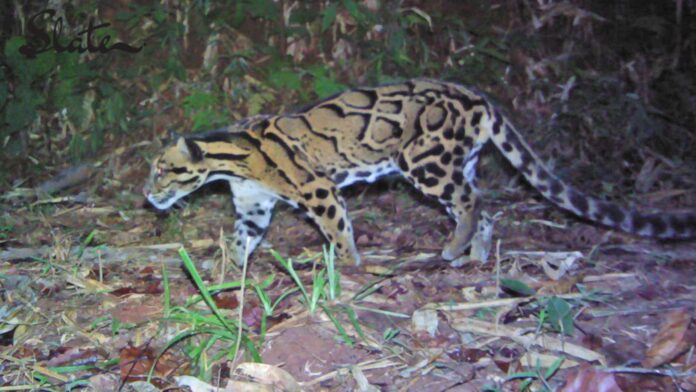By Adity Choudhury
The nocturnal, solitary and shy clouded leopard is the state animal of Meghalaya. Experts believe that this arboreal wild cat was the first to have genetically diverged from the common ancestor of the pantherine cats, with the approximate timeline being 9.32 to 4.47 million years ago.
It is now extinct locally in different parts of Southeast Asia, with a total population said to be fewer than 10,000 mature individuals. The International Union for Conservation of Nature: Red List of Threatened Species (or the IUCN Red List) has listed the species as ‘Vulnerable’.
In recent times, their presence has been confirmed in Meghalaya, via camera trap. Foremost in the scene is Nongkhyllem Wildlife Sanctuary (NWS), Ri Bhoi district, which was awarded the best “protected area” by a report on management effectiveness evaluation (MEE).
Sachin Gavade, Divisional Forest Officer (DFO), Meghalaya, gave insights into the conservation efforts of the clouded leopard. We focused on data deficiency, including challenges of conservation in the state.
There is no accurate number at the moment. “The population assessment is going on, under the Clouded Leopard Programme (CLP), Ministry of Environment, Forest and Climate Change, operational since 2021. We are doing camera trapping, but conclusive results are yet to come.”
The clouded leopard falls under “Scheduled” animal. Some animals are very important from the ecological perspective; hence, steps are taken for their conservation.
He further highlighted that their decline results from human activity and deforestation. That said, people’s participation is a hopeful change. “Increasing forest reserve areas will increase their population. Mass participation is very important, with respect to two challenges in particular – jhum cultivation, which degrades the forest and economic activities like horticulture crops (areca nut cultivation, for example).”
For the clouded leopard, there is no mass movement yet. In Meghalaya, only five per cent area comes under government forests, as reserve forests and sanctuaries, while 95 per cent is with the community, making local communities, significant stakeholders.
A breeding programme for the clouded leopard in Umtrew – where a new zoo is likely to come up – is about to be initiated. The department has proposed conservation-breeding centres here.
Our conversation shifted to the IUCN Red List – the difference between “critically endangered” and “vulnerable”.
Vulnerable means there is no imminent threat, provided the risks are countered while there is still time. Critically endangered, on the other hand, refers to factors beyond human control where reversal is impossible without solid interventions.
In the quest for the clouded leopard, Slate went to Nongkhyllem Wildlife Sanctuary, carved out of the Nongkhyllem Reserve Forest, with an area size of 29 sq km.
While we could not locate the clouded leopard, we met the Range Forest Officer (RFO), Leening Wahlang. In between trekking, safari rides, resting, and the constant presence of leeches, he spoke about the situation on the ground. We also interacted with the Shillong-based, Conservation Initiatives, who had come to NWS for research.
Speaking about the sanctuary, Biang La Nam Syiem, a PhD researcher at Deakin University, Australia, said, “Nongkhyllem is the only remaining contiguous old growth forest in Ri Bhoi district, and holds a very important position for conservation.”
On the shortage of data with regard to the clouded leopard, he said, “Systematic surveys and scientific studies should be the focus areas to assess their distribution and get a sense of the population status in Meghalaya.”
The motto of Conservation Initiatives – Nurturing nature, rooted in science – speaks volumes about their work. In Meghalaya, they focus on the conservation of birds and the western hoolock gibbon, to name a few.
We spoke to Dr. Varun Goswami and Dr. Divya Vasudev, senior scientists and founders of this organisation, who shared their thoughts on community-level engagement for conservation.
Vasudev said, “In Meghalaya, a large proportion of forests are owned and managed by the community.
They’ve preserved forests and instituted their own village-level regulations on natural resource extraction and hunting, for instance.
They also depend heavily on the forests, for water, firewood and bamboo to construct their houses. Forests and local communities share a symbiotic relationship.”
Goswami added, “It’s really important as a model of conservation to think of participatory approaches where the government, local communities and citizens of the state come together to facilitate and aid conservation. One could partner with local communities to chart new paths.”
Giving us an overview of clouded leopards, Wahlang said that a few have been captured on camera traps, adding that monitoring and evaluation are on, in collaboration with Aaranyak, Assam. “It’s difficult to spot the clouded leopard. One needs a lot of patience to spot it here in Nongkhyllem.”
On why conservation matters, Wahlang said that it is for future generations. “Involve children, and the whole village participates. Let there be dancing and painting competitions. Let imagination run free.”
While the distribution of the elusive clouded leopard cannot be ascertained now, what is hopeful is how Nongkhyllem continues to inspire community-level engagement in the Ri Bhoi area. Perhaps a day will come when the state animal of Meghalaya will be given its due respect.
(The writer is a features coordinator with The Meghalayan)


